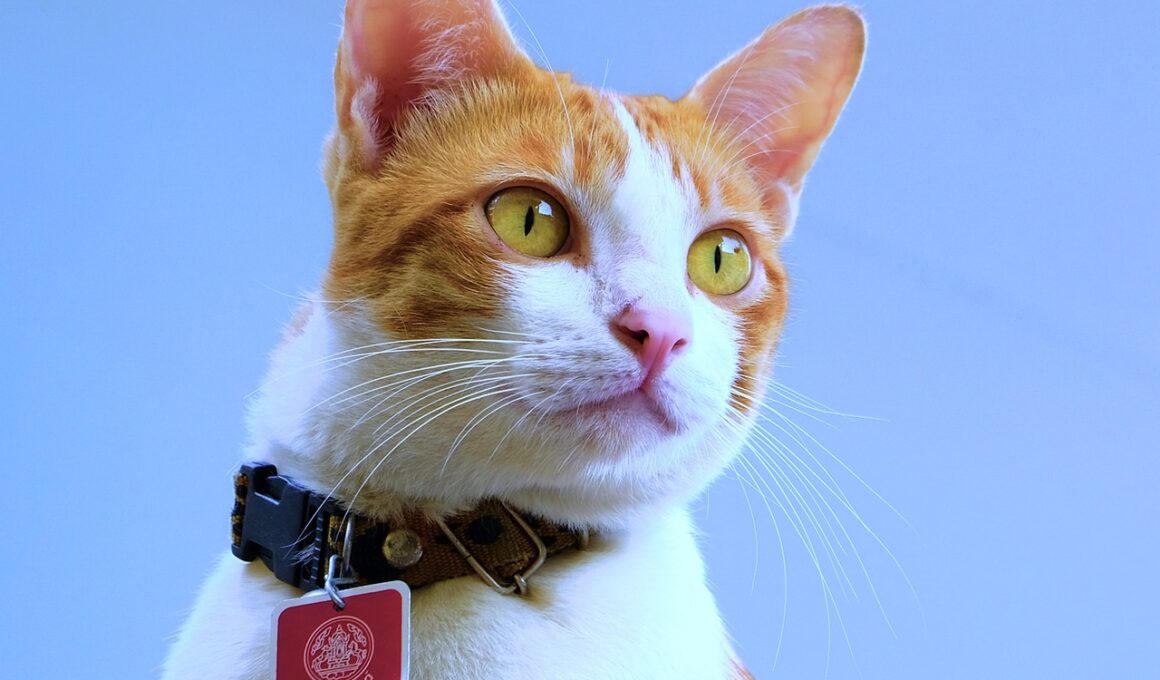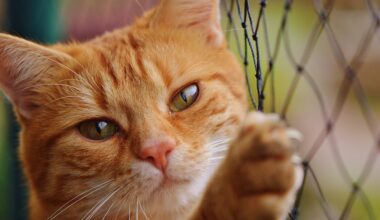Collar Safety: When to Remove Your Cat’s Collar
Understanding collar safety for your cat is essential for their well-being and comfort. Cats are curious creatures and love to explore their surroundings. A collar can help identify them if they get lost. However, there are instances when keeping a collar on your cat may pose a risk. This can include various situations that could result in injury or distress. For instance, outdoor adventures are one situation where a collar could get caught on branches or fences. If this happens, a cat may panic, leading to potential injury. Choosing a breakaway collar designed to release under pressure may alleviate some of these risks. Yet, it’s crucial to regularly monitor your cat’s collar to ensure it fits correctly. Additionally, cat collars can cause irritation if worn for prolonged periods, particularly if they are too tight. The collar’s material should also be taken into consideration. Opt for softer materials that are comfortable against your cat’s fur. Be vigilant and ensure that collar safety is part of your routine care for your feline friend, as their safety should always be a top priority.
Signs It’s Time to Remove the Collar
Recognizing when it’s time to remove your cat’s collar is paramount for their safety. If you notice signs of discomfort, such as excessive scratching around the neck, you should consider taking the collar off. Cats often try to remove something that irritates them, leading to potential skin injuries. Additionally, if the collar shows signs of wear, like fraying or broken buckles, this is a clear indicator to remove it. A damaged collar might not only become ineffective for ID purposes but could also pose a choking hazard. It’s also a good practice to assess the collar size periodically as your cat grows or gains weight. It may become too tight or too loose, either of which can cause problems. Another situation to consider is the collar’s material. If you observe any signs of allergy or irritation, such as redness or swelling at the collar site, this should prompt immediate removal. Always keep a close eye on your cat’s physical condition and remove the collar if any concerns arise immediately.
When allowing outdoor time for your cat, be aware of the potential dangers associated with collars as it contributes to collar safety for your pet. Cats naturally climb and explore, which may result in their collars getting caught on objects. This can lead to choking or strangulation, risks that all cat owners should take seriously. As a precautionary measure, consider providing a designated outdoor space or leash training instead. Another solution is using a collar with a safety breakaway feature, allowing it to release when pulled with strong force. However, breakaway collars must fit appropriately to function correctly, which means checking them frequently is vital for your cat’s health. Avoid using traditional collars for outdoor excursions without considering these dangers. Be mindful of your environment, such as densely wooded areas where a collar could easily become snagged. If your cat enjoys climbing trees or hiding in thick foliage, collar safety becomes even more critical. Encourage safe play and choose appropriate options to protect your feline companion during outdoor adventures, as their safety remains a top concern for conscientious pet owners.
Indoor Cat Collar Guidelines
Even for indoor cats, collar safety remains an important topic to consider. While the perceived risks of collars outdoors are well-documented, indoor cats can also face potential dangers. For example, if a cat engages in rough play with other pets, their collar could lead to injuries. It’s wise to select a collar designed specifically for indoor use. Moreover, keeping your cat’s collar light and evaluation of their comfort should always be your priority. Spending time at home should be a joyful experience for cats, not associated with discomfort from tight or heavy collars. It’s essential to find a suitable option that feels secure yet comfortable. Regularly check under your cat’s chin for any signs of wear or irritation caused by collar friction. Make it part of your routine to inspect their collar for any impacts on their daily activities. If your cat resists wearing a collar, finding alternative means of identification, like microchipping, can offer additional peace of mind while limiting discomfort.
A proper identification solution for your cat may not always necessitate a collar. Microchipping offers a reliable alternative and can significantly enhance your cat’s safety. In fact, microchips are tiny devices implanted under the skin that contain unique identification information. Unlike collars, microchips are permanent and cannot be lost or removed. This is particularly important for outdoor or roaming cats who risk losing their collars. Moreover, many shelters and rescue organizations use scanning services to locate owners of lost pets, providing peace of mind for cat owners. However, it’s essential to remember that microchips are not visible identifiers, so having a collar could still be beneficial. A collar can hold your contact information directly, making it easier for someone to return your lost cat. An ideal solution is to utilize both methods – a collar with ID and a microchip. This dual approach maximizes identification safety while allowing your cat to enjoy outdoor exploration. Always prioritize both identification methods to ensure your beloved feline is always protected.
Collar Maintenance and Monitoring
To enhance collar safety for your cat, regular maintenance and monitoring should always be part of your routine. Periodic checks can prevent many issues that stem from wearing collars. First, assess the collar’s fit; a properly fitted collar should allow for two fingers to slip under it without any tightness. If your cat is uncomfortable, consider adjusting or replacing the collar as needed. Furthermore, be vigilant about inspecting the collar for visible signs of wear, such as fraying or a loose buckle. Accidental opening may result in your cat losing it, posing safety concerns. Additionally, cleaning the collar is essential for hygiene; dirt and bacteria can accumulate over time, potentially causing skin irritations. Regularly wash and dry the collar according to the manufacturer’s instructions to avoid buildup. Don’t just check the collar periodically; make it a habit to assess your cat’s overall comfort and analyze their behavior, addressing any concerns that may arise. Prioritizing maintenance ensures your pet remains safe and comfortable while wearing a collar, providing peace of mind for every cat owner.
Choosing the right collar type contributes significantly to collar safety. Various types of collars exist, each with unique features designed for different needs. Breakaway collars are amongst the safest options, releasing when too much pressure is applied, minimizing risks of choking. Consider reflective collars if you plan on letting your cat outside at dusk or dawn; they provide extra visibility, ensuring your cat is seen by others. If you prefer a stylish look, ensure functionality still lingers over aesthetics. Collars with personalized ID tags are valuable in helping others identify your lost pet instantly. Only use collars made from soft and durable materials, ensuring comfort against your cat’s fur. Explore options that allow for proper adjustments, as cats undergo growth phases. Some collars offer varied designs with charming patterns or colors, adding personality while remaining practical. However, avoid collars with excessive embellishments; they can snag on objects, creating potential hazards for your feline companion. Take the time necessary to choose options that encompass both style and safety—all to maintain the highest level of comfort for your cat.
Final Thoughts on Collar Safety
In conclusion, collar safety is of utmost importance when caring for your cat. As responsible pet owners, it’s crucial to remain vigilant about collar monitoring, maintenance, and knowing when to remove the collar. Always choose a collar that suits your cat’s needs and lifestyle. Weighing the pros and cons of using collars versus alternatives is crucial. Microchipping alongside a collar offers an excellent identification solution, combining safety and ease of return. Additionally, familiarize yourself with your cat’s behavior to determine what makes them comfortable while wearing a collar and helps identify when it may need to be removed. Explore various types of collars available to discover the best fit for your furry friend. Keep their collar clean, and check for wear regularly to maintain safety and comfort. Always prioritize your cat’s well-being by considering these factors while nurturing a safe environment. With proper attention and care, you can ensure your cat remains both stylish and safe in their collar. Ultimately, the decision should always center around your cat’s happiness, comfort, and safety as you embark on this journey together.


